Abstract
A compact and triple-band polarization converting reflective type metasurface (PCRM) with a high polarization conversion ratio (PCR) is proposed for strategic wireless antenna-integrated applications. The unit cell of the metasurface is composed of S- and G-shaped patches separated with a parasitic gap and the grounded via is connected to the full ground plane. The unit cell is etched on an FR4 substrate (dielectric constant, εr = 4.4, loss tangent, tan δ = 0.02), with compact dimensions of 10 mm3 × 10 mm3 × 1.6 mm3. This structure provides a resonance at 5.2 (ISM), 6.9, and 8.05 GHz (X-band) frequencies. The designed unit cell structure is studied for Transverse Electric (TE)/Transverse Magnetic (TM) incident waves and their responses to the various incident angles. The corresponding PCR is calculated, which shows 92% in the lower frequency band (5.2 GHz), 93% in the second frequency band (6.9 GHz), and 94% in the high-frequency band (8.05 GHz). The total efficiency of the structure shows 83.2%, 62.95%, and 64.6% at the respective resonance bands. A prototype of the proposed PCRM with 3 × 3 unit cells is fabricated to validate the simulated results. The experimental data agrees with the simulation results. The compactness, triple-band operation with a high PCR value of more than 92% makes use of the designed metasurface in wireless antenna-integrated applications at ISM and X-bands.
1. Introduction
Metasurfaces (MS) are artificially engineered two-dimensional structures, which have the capability of manipulating Electromagnetic (EM) propagation behavior. The MS consists of sub-wavelength periodic structures called unit cells [1,2]. The controllable characteristic parameters of EM waves are amplitude and phase. Thus, MS can be utilized for the realization of functionalities like polarization, gain control, and amplitude control [3]. The applications of these functionalities are used to realize perfect absorbers [4], frequency selective surfaces (FSS) [5], AMC reflectors and polarization converters [6] based on epsilon negative, and epsilon near to zero properties [7]. The metasurface is highly efficient in acquiring low-profile, high-efficiency, and broadband polarization converters [8]. Polarization converters have distinct properties in controlling polarization and they have been utilized in the microwave [9], terahertz [10], and even optical [11] range of frequencies.
Polarization conversion is one of the functionalities required for current wireless devices to control polarization, gain, radar cross-section (RCS), etc. The realization of polarization converting MS can be done in two operating modes: transmission [12] and reflection [13]. Based on the type of polarization conversion, each mode is categorized into linear to circular, circular to linear, linear to linear, and cross-polarization conversion MS [14,15,16]. Most of the realized polarization-converting MSs are limited to broadband [17], ultra-wideband [18], wideband [19], and dual-band operation only [20]. However, to meet the current demand for wireless devices, there is a need to extend functionality to multiband. Various multifunctional and multi-polarization conversion metasurfaces were realized in the literature using different reconfiguration mechanisms [21,22,23]. These metasurfaces provided a challenge in terms of active component integration and the loss generated by these active components. Hence the synthesis of compact, passive polarization-converting metasurfaces have become the solution to the above challenge. Only a few works have reported on multi-band passive polarization converting MS with compact size, high polarization conversion ratio (PCR) values, and high performance [24,25,26,27,28,29,30].
In this paper, the design of a triple-band cross-polarization converting metasurface based on reflection is illustrated with compact dimensions and high PCR values. The unit cell structure resonates at 5.2 GHz, 6.9 GHz, and 8.05 GHz frequencies. The corresponding polarization conversion ratio is 92%, 93%, and 94%, respectively. The total efficiencies are 83.2%, 62.95%, and 64.6% at respective operating bands. For the incidence and polarization angles of the incident wave, the structure provides angular stability up to 30° incident angles, and it acts as a polarization-sensitive metasurface for polarization angles. Similarly, the characteristics of TM and TE incidents on the surface are studied. The simulated characteristics are experimentally validated using a 3 × 3 PCRM fabricated prototype. The compactness, high PCR, and triple-band feature make it suitable for the implementation in strategic antenna-integrated applications for ISM and X-bands.
2. Design and Simulation Analysis
2.1. Unit Cell Configuration
A schematic diagram of the reflective type cross-polarization converting metasurface with the simulated setup is shown in Figure 1a. A single-layer FR4 lossy is used as a substrate with dielectric constant (εr) = 4.4 and loss tangent (tan δ) = 0.002. S-and G-shaped metal patches separated with a parasitic gap and grounded via to the S-shape that makes the structure resonate at 5.2, 6.9, and 8.05 GHz. The unit cell dimensions are 10 mm3 × 10 mm3 × 1.6 mm3. The geometric dimensions of the unit cell are shown in Figure 1b. The numerical simulation software CST MWS is used for design and simulated analysis.
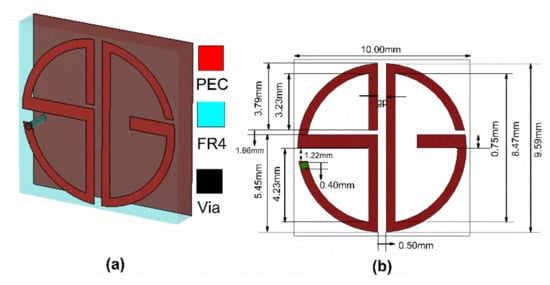
Figure 1.
(a) Perspective view of the Unit cell; (b) Unit cell dimensions.
The simulation setup consists of a linearly polarized plane wave incidence in the Z-direction, while the unit cell structure lies in an XY plane. The reflected electric fields consist of co-polarization (S11 & S22) and cross-polarization components (S12 & S21), which are related using Equation (1):
i—incident wave; r—reflected wave; where and .
The investigation of the cross-polarization conversion behavior of the proposed structure is carried out under linear polarized incidence. Figure 2a,b depicts the simulated reflection characteristics of the design. The structure provides three co-polarized (S11) resonating bands at 5.2, 6.9, and 8.05 GHz.
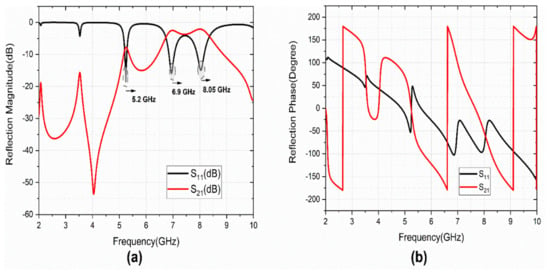
Figure 2.
Simulated unit cell Co-and Cross-polarized Reflection characteristics (a) magnitude, (b) phase.
The cross-polarized reflection coefficient (S21) also has peaks at operating bands. The reflection phase of the co-and cross-polarized component gives the reflected phase details for the linearly polarized incident wave. The phase difference between the co-and cross-polarized components indicates that the cross-polarization conversion mechanism of the designed metasurface to operate in triple-bands. The simulated analysis is carried out with CST MWS software. The equivalent inductance (L) and capacitance (C) values for the S-shape patch are Ls and Cs. Similarly, LG and CG are the equivalent values for G-shape. The Lvia is the inductance of grounded via. Then, the resonance of the structure element is calculated as: .The equivalent LC-circuit model for the design is presented in Figure 3a. The role of via in the design is studied with the simulated S11 (dB), as shown in Figure 3b. It is observed that the resonant frequency is lowered with triple-band operation.
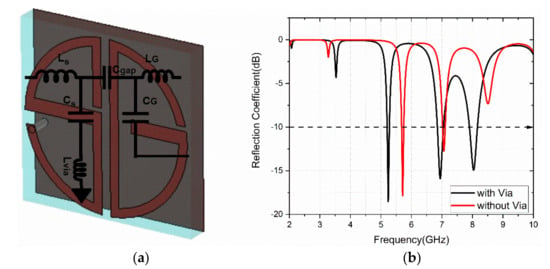
Figure 3.
(a) Unit cell equivalent LC-circuit model representation; (b) Comparison of S11 with and without via.
The physical significance of the structure is studied using a parametric analysis of the gap (gp variable) between the S-and G-shaped patches. The simulated S11 and S21 results for gap variation are presented in Figure 4. It is observed that the optimized gap is obtained at gp = 0.5 mm for triple-band operation.
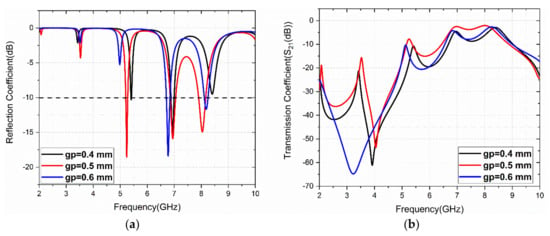
Figure 4.
Parametric analysis of gap (gp) between S-and G-patches: (a) S11 (dB), (b) S21 (dB).
2.2. Response to the Incident Angle and Polarization Angle Variation
The reflection characteristics of the metasurface under different incident angles (theta) and polarization angles are studied. The simulated theta and phi variations are performed with a variation from 0° to 90° a step width of 15°. Figure 5 illustrates the co-polarized reflection characteristics. It provides angular stability of up to 30° theta variations. Figure 6 represents the reflection characteristics of the cross-polarization reflection coefficient. A few minor variations are observed with theta variation.
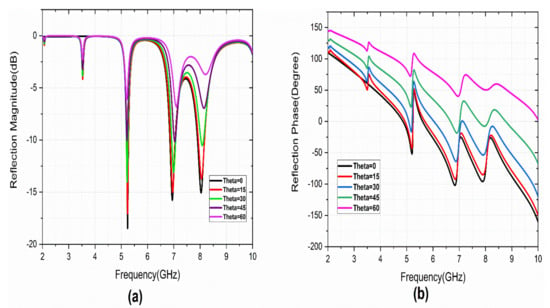
Figure 5.
S11 variation with Theta variation: (a) magnitude, (b) phase.
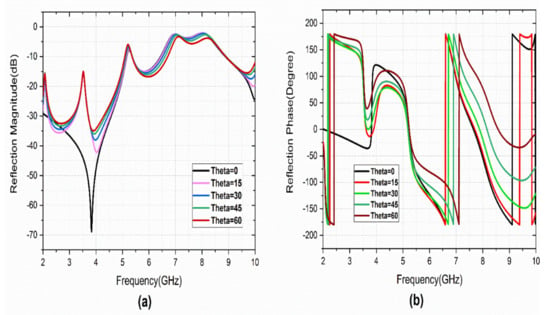
Figure 6.
S21 variation with Theta variation: (a) magnitude, (b) phase.
The metasurface is studied further for polarization angle variation. The structure is polarization-sensitive, as the reflection characteristics are not matched with the normal incident wave. The evidence for the simulation results is shown in Figure 7. The simulation results show that the metasurface is polarization-sensitive and provides the cross-polarization conversion operation with the angular stability of 30° of incident angle.

Figure 7.
Reflection characteristics under Phi variation: (a) magnitude, (b) phase.
2.3. Analysis with TE and TM Incident Wave
The reflection characteristics of the PCRM with vertically polarized (TE) and horizontally polarized (TM) wave incident angle (theta) variation is studied. Figure 8 illustrates the reflection characteristics of the metasurface under TE incidence. It is observed that small variations in reflection magnitude and phase are observed. For these variations, a corresponding variation in S21 is also observed, which also gives the PCRM the ability to work as a polarization converter under TE incident angle variation.
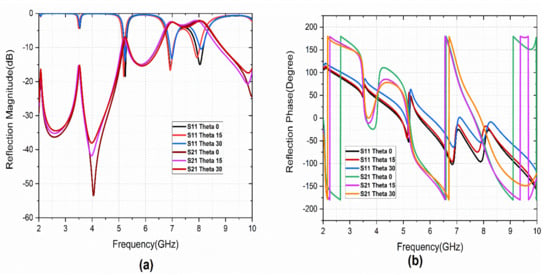
Figure 8.
Reflection characteristics under TE incident angle variation: (a) magnitude, (b) phase.
Under the TM incident wave, the metasurface is affected by the fundamental mode of resonance because this resonance is provided by the magnetic resonance of the structure. For the other higher resonant frequencies, similar results are observed as in TE incident angle variations. Figure 9 shows the reflection characteristics under TM theta variation.
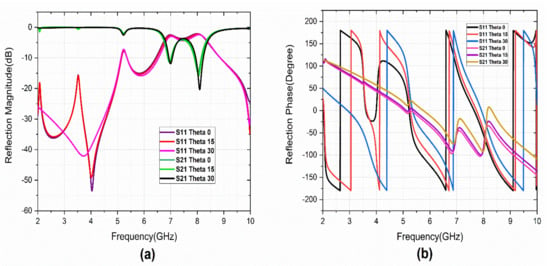
Figure 9.
Reflection characteristics under TM incident angle variation: (a) magnitude (b) phase.
2.4. Analysis of Surface Current Distribution
The resonance phenomenon and the cross-polarization conversion mechanism can be studied using surface current distribution. Figure 10 illustrates the surface current distribution at the three resonant frequencies. The surface current is mostly distributed on the S-shape with the via and patch current direction being out of phase with the ground, which causes magnetic resonance at 5.2 GHz. The current intensity is on the G-shape with an in-phase current direction at 6.9 GHz, which makes electric resonance. Whereas the higher-order resonance is generated by both the S-and G-shape patches. Thus, the lower polarization conversion band is provided by the S-shape, and the second mode is due to the G-shape and the higher mode is generated by both the S-and G-shape with the parasitic gap.

Figure 10.
Simulated Surface current distribution at 5.2, 6.9, and 8.05 GHz.
Performance Analysis
The cross-polarization conversion efficiency of the design is quantified in terms of PCR. PCR can be calculated from the co-and cross-polarized reflection magnitudes as represented in Equation (2):
ryx represents a cross-polarized component, i.e., S21, and rxx represents the co-polarization component, i.e., S11. The highest polarization conversions obtained are 92% for the first operating band, 94% for the second operating band, and 93% for the third operating band under normal incidence. The PCR variation with oblique angles of the incident wave (theta) is also calculated and presented in Figure 11. Incident angles of up to 30° provides a PCR value of more than 85%.
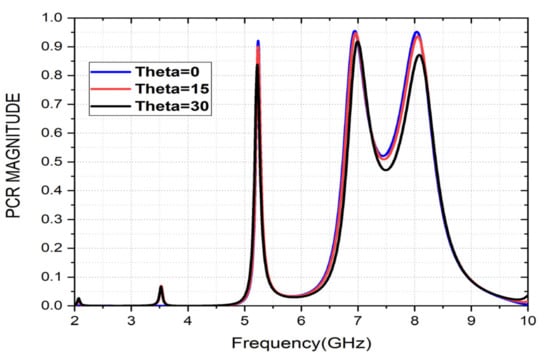
Figure 11.
PCR Variation for various incident angles (theta).
3. Experimental Setup and Results
To validate the design, a 3 × 3 experimental sample was fabricated and measured, and the co-and cross-polarization reflection characteristics were calculated, as well as the PCR value. The fabricated sample is given in Figure 12. The schematic diagram of the experimental setup for characterization is shown in Figure 13. Anritsu MS2037C VNA and two standard horn antennas were used as transmitters and receivers with x-and y-polarization. The measured and calculated results agreed well. The observed variations in measured results were due to fabrication and measurement errors only. Figure 14 shows the comparison between simulated and measured results of the reflection magnitude and PCR under the normal incidence of the incoming wave. The variation in measured results was due to fabrication errors and size limitations of the prototype in the measurement setup. The measured results were taken at normal incidence angles.
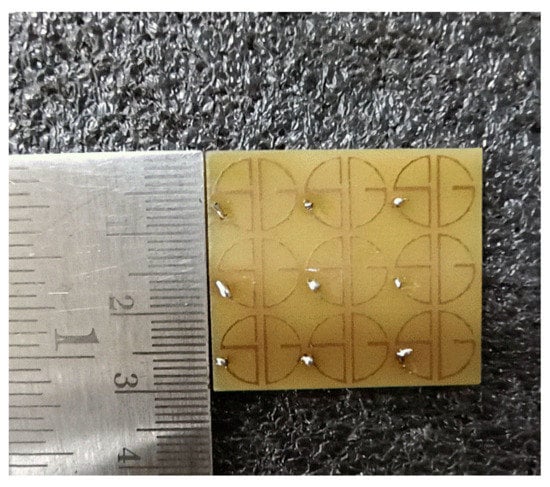
Figure 12.
Fabricated 3 × 3-unit cell prototype.
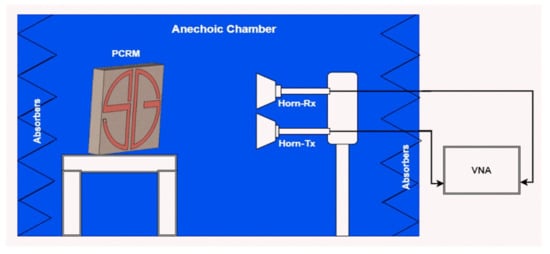
Figure 13.
Schematic of the measurement setup.
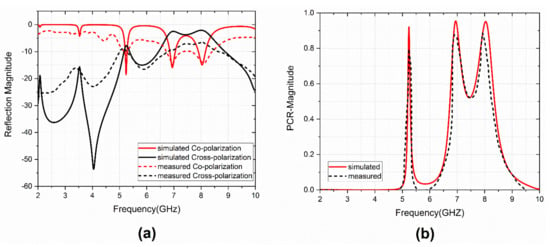
Figure 14.
Comparison between simulated and measured results: (a) reflection magnitude, (b) PCR.
The simulated and measured total efficiency is shown in Figure 15. The measured data shows similar efficiency curves as the numerically computed total efficiency. However, the measured efficiency was observed to be a little lower than the simulated values due to substrate losses.
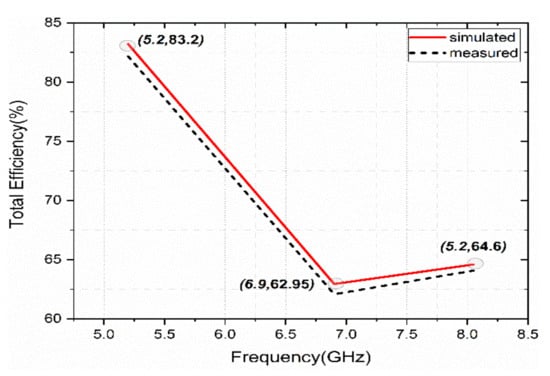
Figure 15.
Total efficiency as a function of frequency.
Table 1 presents a comparison of the designed triple-band reflective cross-polarization converter with the state-of-the-art related works reported in the literature. It can be observed that the proposed metasurface provides a triple-band operation with a relatively compact size. The structure consists of parasitic patch elements with grounded via that acted as a cross-polarization converter with PCR of >92%. Moreover, it offers high PCR values, which is one of the essential requirements for the current wireless communication systems. The physical mechanism of the realized structure is verified using numerical simulations and experimental characterization of a 3 × 3 array sample. There are few works that have a smaller size [24,29]. However, ref. [24] did not perform an analysis of PCR, while ref. [29] has lower PCR values.

Table 1.
Comparison with other related works.
4. Conclusions
In this article, a triple-band, compact PCRM is designed, and its characteristics are studied under incidence and polarization angles. The physical significance of the structural elements is presented along with an equivalent LC-circuit model representation and a detailed parametric analysis. The simulated results show that it provides angular stability of up to 300 of incidence angle and is sensitive to the polarization angle. It provides PCR values of 92%, 93%, and 94% at 5.2, 6.9, and 8.05 GHz. The PCR values under TE and TM modes are also calculated, and the operating mechanism is demonstrated through surface current distribution. The total efficiency of reflecting PCRM is 83.2%, 62.95%, and 64.6%, at resonating bands. These results are compared with the existing triple-band reflecting metasurface in terms of angular stability, unit cell size, and PCR. The features, such as compactness and triple-band operation with PCR values, have strategic antenna-integrated applications for ISM and X-band communications.
Author Contributions
Conceptualization: B.A.B. and B.T.P.M.; methodology: B.A.B. and S.D.; software: B.A.B. and N.H.; validation: S.D.; B.T.P.M. and S.S.A.; formal analysis: N.H. and S.S.A.; writing—original draft preparation: B.A.B.; B.T.P.M. and S.D.; writing—review, and editing: N.H.; S.S.A. And N.K.; supervision: B.T.P.M. and N.K.; Project administration: N.K. All authors have read and agreed to the published version of the manuscript.
Funding
This work was supported by the Institute of Information & Communications Technology Planning & Evaluation (IITP) grant funded by the Korean government (MSIT) (No. 2022-0-01031, Development of measured EMF big data analysis and management platform).
Institutional Review Board Statement
Not applicable.
Informed Consent Statement
Not applicable.
Data Availability Statement
Not applicable.
Conflicts of Interest
The authors declare no conflict of interest.
References
- Bukhari, S.S.; Vardaxoglou, J.; Whittow, W. A Metasurfaces Review: Definitions and Applications. Appl. Sci. 2019, 9, 2727. [Google Scholar] [CrossRef]
- Hsu, W.-L.; Chen, Y.-C.; Yeh, S.P.; Zeng, Q.-C.; Huang, Y.-W.; Wang, C.-M. Review of Metasurfaces and Meta devices: Advantages of Different Materials and Fabrications. Nanomaterials 2022, 12, 1973. [Google Scholar] [CrossRef]
- Zhang, L.; Mei, S.; Huang, K.; Qiu, C.-W. Advances in Full Control of Electromagnetic Waves with Metasurfaces. Adv. Opt. Mater. 2016, 4, 818–833. [Google Scholar] [CrossRef]
- Liang, Y.; Lin, H.; Koshelev, K.; Zhang, F.; Yang, Y.; Wu, J.; Kivshar, Y.; Jia, B. Full-stokes polarization perfect absorption with diatomic metasurfaces. Nano Lett. 2021, 21, 1090–1095. [Google Scholar] [CrossRef]
- Alwareth, H.; Ibrahim, I.M.; Zakaria, Z.; Al-Gburi, A.J.A.; Ahmed, S.; Nasser, Z.A. A wideband high-gain microstrip array antenna integrated with frequency-selective surface for Sub-6 GHz 5G applications. Micromachines 2022, 13, 1215. [Google Scholar] [CrossRef]
- Sun, Z.; Liu, R.; Cao, H.; Gong, H.; Du, M.; Li, S. Dual-Axis Metasurface Strain Sensor Based on Polarization–Phase-Deformation Relationship. Sensors 2020, 20, 1307. [Google Scholar] [CrossRef]
- Pang, K.; Alam, M.Z.; Zhou, Y.; Liu, C.; Reshef, O.; Manukyan, K.; Voegtle, M.; Pennathur, A.; Tseng, C.; Su, X.; et al. Adiabatic frequency conversion using a time-varying epsilon-near-zero metasurface. Nano Lett. 2021, 21, 5907–5913. [Google Scholar] [CrossRef]
- Majeed, A.; Zhang, J.; Ashraf, M.A.; Memon, S.; Mohammadani, K.H.; Ishfaq, M.; Sun, M. An Ultra-Wideband Linear-to-Circular Polarization Converter Based on a Circular, Pie-Shaped Reflective Metasurface. Electronics 2022, 11, 1681. [Google Scholar] [CrossRef]
- Sakda, N.; Chitaree, R.; Rahman, B.M.A. Reflective Terahertz Metasurfaces Based on Non-Volatile Phase Change Material for Switchable Manipulation. Photonics 2022, 9, 508. [Google Scholar] [CrossRef]
- Rahman, B.M.A.; Viphavakit, C.; Chitaree, R.; Ghosh, S.; Pathak, A.K.; Verma, S.; Sakda, N. Optical Fiber, Nanomaterial, and THz-Metasurface-Mediated Nano-Biosensors: A Review. Biosensors 2022, 12, 42. [Google Scholar] [CrossRef] [PubMed]
- Ullah, N.; Zhao, R.; Huang, L. Recent Advancement in Optical Metasurface: Fundament to Application. Micromachines 2022, 13, 1025. [Google Scholar] [CrossRef] [PubMed]
- Li, X.; Wang, Y.; Fan, J.; He, J.; Huang, X. Ultra-Thin/Wide-Band Polarization Conversion Metasurface and Its Applications in Anomalous Reflection and RCS Reduction. Appl. Sci. 2022, 12, 7696. [Google Scholar] [CrossRef]
- Sui, R.; Wang, J.; Xu, Y.; Feng, D. An X-Band Reflective Active Polarization Conversion Metasurface. Electronics 2022, 11, 2847. [Google Scholar] [CrossRef]
- Mohanty, A.; Behera, B.R.; Esselle, K.P.; Alsharif, M.H.; Jahid, A.; Mohsan, S.A.H. Investigation of a Dual-Layer Metasurface-Inspired Fractal Antenna with Dual-Polarized/-Modes for 4G/5G Applications. Electronics 2022, 11, 2371. [Google Scholar] [CrossRef]
- Tian, Y.; Han, L.; Yan, L.; Wang, J.; Zhang, B.; Jiao, Z. Optically Controlled Terahertz Multifunctional Polarization Conversion Metasurface with Reflection and Transmission Modes. Micromachines 2022, 13, 1387. [Google Scholar] [CrossRef] [PubMed]
- Ahmad, T.; Rahim, A.A.; Bilal, R.M.H.; Noor, A.; Maab, H.; Naveed, M.A.; Madni, A.; Ali, M.M.; Saeed, M.A. Ultrawideband Cross-Polarization Converter Using Anisotropic Reflective Metasurface. Electronics 2022, 11, 487. [Google Scholar] [CrossRef]
- Mao, C.; Yang, Y.; He, X.; Zheng, J.; Zhou, C. Broadband Reflective Multi-Polarization Converter Based on Single-Layer Double-L-Shaped Metasurface. Appl. Phys. A 2017, 123, 767. [Google Scholar] [CrossRef]
- Gao, X.; Han, X.; Cao, W.-P.; Li, H.O.; Ma, H.F.; Cui, T.J. Ultrawideband and High-Efficiency Linear Polarization Converter Based on Double V-Shaped Metasurface. IEEE Trans. Antennas Propag. 2015, 63, 3522–3530. [Google Scholar] [CrossRef]
- Zheng, Q.; Guo, C.; Ding, J. Wideband Metasurface-Based Reflective Polarization Converter for Linear-to-Linear and Linear-to-Circular Polarization Conversion. IEEE Antennas Wirel. Propag. Lett. 2018, 17, 1459–1463. [Google Scholar] [CrossRef]
- Kamal, B.; Chen, J.; Yin, Y.; Ren, J.; Ullah, S.; Ali, U. Design and Experimental Analysis of Dual-Band Polarization Converting Metasurface. IEEE Antennas Wirel. Propag. Lett. 2021, 20, 1409–1413. [Google Scholar] [CrossRef]
- Wu, P.C.; Zhu, W.; Shen, Z.X.; Chong, P.H.J.; Ser, W.; Tsai, D.P.; Liu, A.-Q. Broadband wide-angle multifunctional polarization converter via liquid-metal-based metasurface. Adv. Opt. Mater. 2017, 5, 1600938. [Google Scholar] [CrossRef]
- Li, W.; Xia, S.; He, B.; Chen, J.; Shi, H.; Zhang, A.; Li, Z.; Xu, Z. A Reconfigurable Polarization Converter Using Active Metasurface and Its Application in Horn Antenna. IEEE Trans. Antennas Propag. 2016, 64, 5281–5290. [Google Scholar] [CrossRef]
- Sun, S.; Jiang, W.; Gong, S.; Hong, T. Reconfigurable Linear-to-Linear Polarization Conversion Metasurface Based on PIN Diodes. IEEE Antennas Wirel. Propag. Lett. 2018, 17, 1722–1726. [Google Scholar] [CrossRef]
- Liu, X.; Zhang, J.; Li, W.; Lu, R.; Li, L.; Xu, Z.; Zhang, A. Three-Band Polarization Converter Based on Reflective Metasurface. IEEE Antennas Wirel. Propag. Lett. 2017, 16, 924–927. [Google Scholar] [CrossRef]
- Huang, X.; Yang, H.; Zhang, D.; Luo, Y. Ultrathin Dual-Band Metasurface Polarization Converter. IEEE Trans. Antennas Propag. 2019, 67, 4636–4641. [Google Scholar] [CrossRef]
- Yang, Z.; Yu, S.; Kou, N.; Long, F.; Ding, Z.; Zhang, Z. Ultrathin Tri-Band Reflective Cross-Polarization Artificial Electromagnetic Metasurface. J. Electromagn. Waves Appl. 2020, 34, 1491–1501. [Google Scholar] [CrossRef]
- Lin, B.Q.; Guo, J.X.; Chu, P.; Huo, W.J.; Xing, Z.; Huang, B.G.; Wu, L. Multiple-band Linear-Polarization Conversion and Circular Polarization In Reflection Mode Using Asymmetric Anisotropic Metasurface. Phys. Rev. Appl. 2018, 9, 024038. [Google Scholar] [CrossRef]
- Wu, L.P.; Fang, Q.H.; Pan, W.K.; Li, M.H.; Dong, J.F. Realization of Cross-Polarization Conversion for Linearly Polarized Waves in Multiband by Orthotropic Metasurface. J. Electromagn. Waves Appl. 2022, 36, 101–114. [Google Scholar] [CrossRef]
- Yuan, L.; Hou, L.; Zhang, Z. Triple-Band Highly Efficient Multi-Polarization Converter Based on Reflective Metasurface. Prog. Electromagn. Res. M 2021, 102, 127–135. [Google Scholar] [CrossRef]
- Ghosh, S.; Ghosh, J.; Singh, M.S.; Sarkhel, A. A Low-Profile Multifunctional Metasurface Reflector for Multiband Polarization Transformation. IEEE Trans. Circuits Syst. II Express Briefs 2022. [Google Scholar] [CrossRef]
Publisher’s Note: MDPI stays neutral with regard to jurisdictional claims in published maps and institutional affiliations. |
© 2022 by the authors. Licensee MDPI, Basel, Switzerland. This article is an open access article distributed under the terms and conditions of the Creative Commons Attribution (CC BY) license (https://creativecommons.org/licenses/by/4.0/).